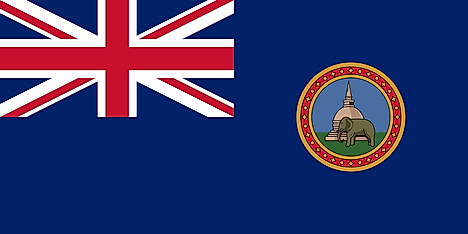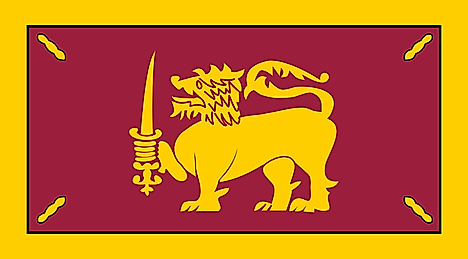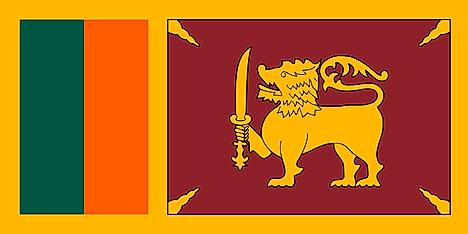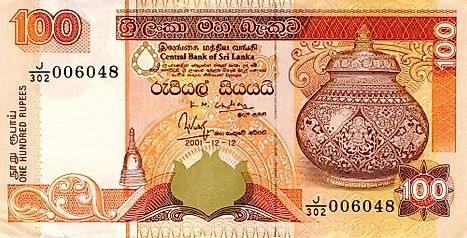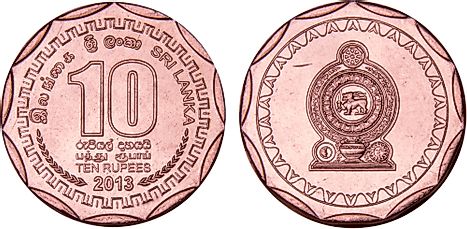Flags, Symbols, & Currencies of Sri Lanka
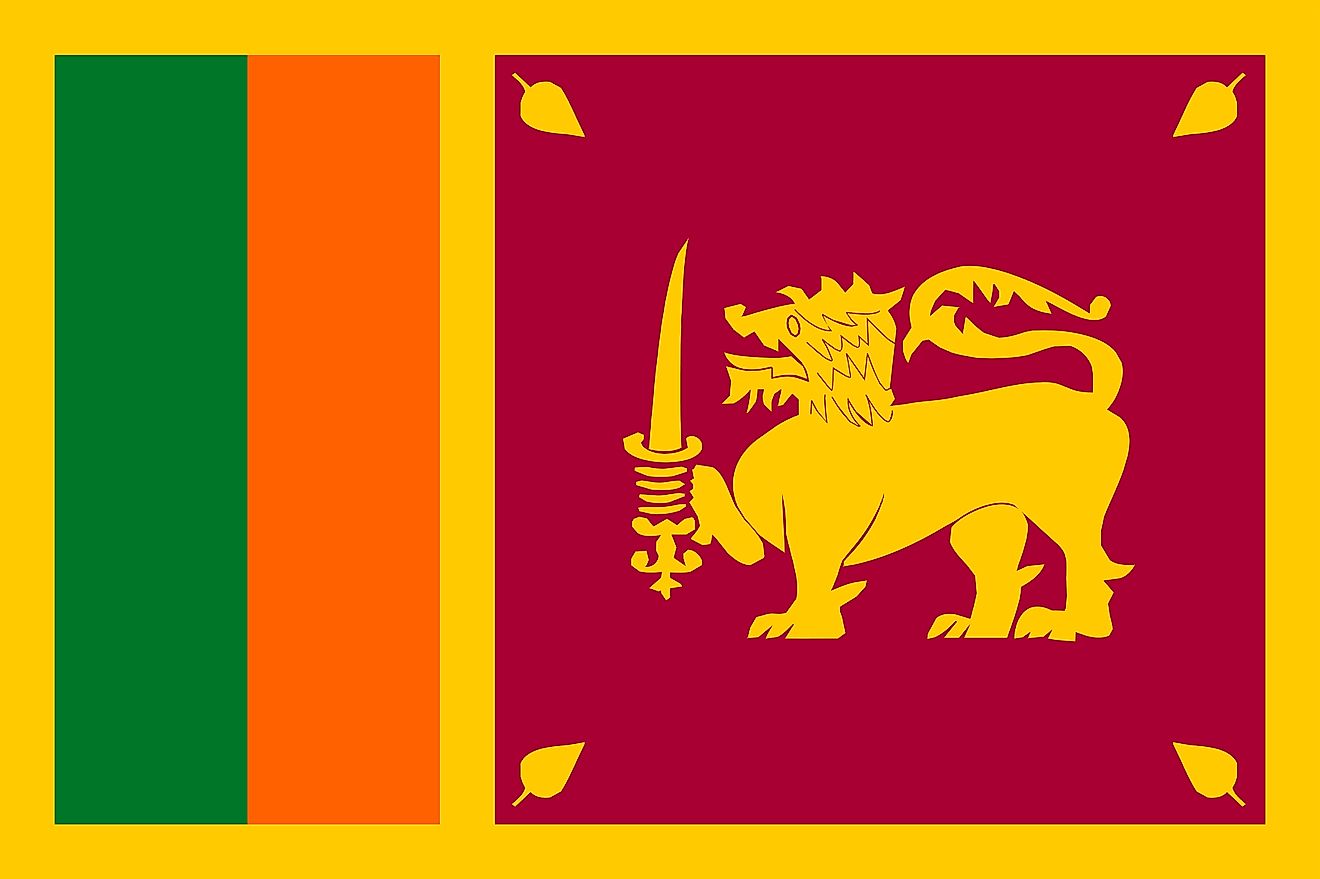
The current flag of Sri Lanka was officially adopted on May 22, 1972, although it had been in use since the 1950’s. Its design consists of a golden yellow background, which holds two images. The first images, located on the hoist side of the flag, is made up of two equal vertical stripes of dark turquoise green color on the left and orange color on the right. Together, these stripes take up approximately one-third of the available flag space. The remaining two-thirds of the flag is occupied by a maroon-colored rectangle, which holds the image of a golden lion. This lion is facing left and holding a small, ceremonial sword in its right, front paw. Each corner of the maroon rectangle is marked by a golden yellow leaf. In any size, the flag of Sri Lanka is represented by a height to width ratio of 1:2.
Each of the images and colors on the flag of Sri Lanka has a special symbolic meaning for the country. The two stripes on the left hand side represent the two major minority groups living in Sri Lanka: Moors (green) and Tamils (orange). The dark turquoise green color stands for the Muslim population. The golden yellow background represents the smaller minority populations also living in this country. The lion situated on the right hand side represents the Sinhalese people, who make up around three-quarters of the population of Sri Lanka. The four bo leaves - symbolizing Buddhism and its influence on the country - stand for the four virtues of kindness, friendliness, happiness, and equanimity. Additionally, the 8 curling hairs on the tail of the lion represent the Noble Eightfold Path of Buddhism. The sword is a symbol of the autonomy of Sri Lanka. Finally, the maroon background stands for the many minority religions that are also practiced in this country.
History of the Flag of Sri Lanka
Throughout history, Sri Lanka has had a number of different flag designs. Prior to the colonial era, Sri Lanka was divided into several kingdoms. The Kingdom of Kandy, located in the central and eastern areas of the island was one of the largest of these islands. From 1798 to 1815, this kingdom utilized the same golden yellow background with maroon rectangle and sword-holding lion that is seen on the current flag design. The only difference between this image and that of the present-day flag was seen on the maroon rectangle, which was bordered by a black line. Under British colonial rule, between 1815 and 1948, the flag of this island had a solid blue background with a small Union Jack symbol in its upper left hand corner. In its right half was situated a circular image that held a monument and an elephant. Sri Lanka reverted back to the lion-only flag from 1948 to 1951, with slight changes to the image style.
Symbols of Sri Lanka
National Coat of Arms of Sri Lanka
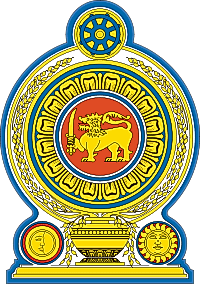
The national emblem of Sri Lanka was adopted in 1972. It features a golden lion in the center, surrounded by petals of gold representing the Blue Lotus flower. The base of the emblem is a traditional grain vase with sprouting sheaves of rice. Sinhalese heraldic symbols of the sun and moon flank either side of the vase. At the top of the emblem is the crest of the Dharmacakra, representing Buddhism.
National Anthem
- Anthem Title: Sri Lanka Matha ("Mother Sri Lanka")
- Music composer and Lyricist: Ananda Samarakoon
- Date of Adoption: 1951
Sri Lanka Matha is the national anthem of Sri Lanka. It was first performed in February 1949 during an official ceremony at the Independence Memorial Hall. The lyrics and music to the song were written by Ananda Samarakoon, with the original song titled "Namo Namo Matha" (Salute! Salute! Motherland). However, other sources indicate that the song writer and composer was Rabindranath Tagore, while some people believe Samarakoon wrote the lyrics and Tagore set them to music.
In 1950, the government of Sri Lanka set up a committee to pick the Sri Lanka's national anthem. After listening to several songs, the committee settled on Namo Namo Matha and made several minor changes before endorsing it as the proposed anthem in 1951. In 1960, the first line of the anthem was changed from "Namo Namo Matha, Apa Sri Lanka" to the current "Sri Lanka Matha, Apa Sri Lanka" against the Samarakoon's wishes. Samarakoon ended up committing suicide in April 1962, citing the anthem's mutilation as the reason for his action
ශ්රී ලංකා මාතා/Sri Lanka Matha (Sinhala)
ශ්රී ලංකා මාතා
අප ශ්රී..... ලංකා නමෝ නමෝ
නමෝ නමෝ මාතා
සුන්දර සිරිබරිනී සුරැඳි අති
සෝබමාන ලංකා
ධාන්ය ධනය නෙක මල් පලතුරු
පිරි ජය භුමිය රම්යා
අප හට සැප සිරි සෙත සදනා
ජීවනයේ මාතා
පිළිගනු මැන අප භක්තී පූජා
නමෝ නමෝ මාතා
අප ශ්රී..... ලංකා නමෝ නමෝ
නමෝ නමෝ මාතා
ඔබ වේ අප විද්
ඔබ මය අප සත්යා
ඔබ වේ අප ශක්ති
අප හද තුළ භක්තී
ඔබ අප ආලෝකේ
අපගේ අනුප්රාණේ
ඔබ අප ජීවන වේ
අප මුක්තිය ඔබ වේ
නව ජීවන දෙමිනේ නිතින අප
පුබුදු කරන් මාතා
ඥාන වීර්ය වඩවමින රැගෙන
යනු මැන ජය භූමී කරා
එක මවකගෙ දරු කැල
බැවිනා
යමු යමු වී නොපමා
ප්රේම වඩා සැම භේද දුරැර දා
නමෝ නමෝ මාතා
අප ශ්රී..... ලංකා නමෝ නමෝ
නමෝ නමෝ මාතා
Mother Sri Lanka
Thou Mother Lanka,
Oh Mother Lanka we salute,
salute, salute, salute Thee!
Plenteous in prosperity, Thou,
Beauteous in grace and love,
Laden with grain and luscious fruit,
And fragrant flowers of radiant hue,
Giver of life and all good things,
Our land of joy and victory,
Receive our grateful praise
sublime, we worship, worship Thee.
Oh Mother Lanka! We salute,
salute, salute, salute Thee!
Thou gavest us Knowledge and
Truth,
Thou art our strength and
inward faith,
Our light divine and sentient
being,
Breath of life and liberation.
Grant us, bondage free,
inspiration.
Inspire us for ever.
In wisdom and strength
renewed,
Ill-will, hatred, strife all ended,
In love enfolded, a mighty nation
Marching onward, all as one,
Lead us, Mother, to fullest
freedom, we worship, worship Thee
Oh Mother Lanka! We salute,
salute, salute, salute Thee!
The Currency of Sri Lanka is the Sri Lankan Rupee
The currency in Sri Lanka is the Sri Lankan Rupee which has a sign of Rs and a currency code LKR. One Sri Lankan Rupee comprises 100 cents. Sometimes, 'Rp' and 'SLR' are used as currency symbol and abbreviation.
Banknotes and Coins
The currently circulating banknotes are of nine denominations. These are, Rs10, Rs20, Rs50, Rs100, Rs200, Rs500, Rs1,000, Rs2,000, and Rs5,000. All banknotes are made up of 100% cotton pulp except for the Rs200 note which was printed on a polymer substance. This note was issued to observe the 50th anniversary of country’s independence (1948–1998).
The CBSL has so far issued eleven series of currency notes. The first note series was King George VI series and it had only two denominations (Rs1 and Rs10). The Queen Elizabeth II series was the second note series. Development, Prosperity, and Sri Lankan Dancers form themes of the eleventh series of the banknotes.
Sri Lanka used the British issued notes until 1951 and the British issued coins until 1963. The first homegrown coins began circulating in 1963. These coins had the Emblem of Ceylon on the obverse (front side). This series had seven coin denominations of Cts1, Cts2, Cts5, Cts10, Cts25, Cts50, and Rs1. The Rs2 and Rs5 denominated coins were introduced in 1984. On November 17, 2014, the CBSL issued a new series of Rs10 denominated coins to represent the twenty five districts of Sri Lanka. These coins featured one or more distinctive archaeological, cultural, economic, environmental, religious, or social characteristics of each of Sri Lanka’s twenty five districts. The designs of these coins were selected by a nationwide competition called "Design and Shine".
Historical Currencies of Sri Lanka
The first paper currency was introduced in Sri Lanka during the Dutch period (1640 AD - 1796 AD). It was known as Kredit Brieven or Kas-nooten. Some of the ancient coins and notes prevalent in Sri Lanka were Kahapana (punch marked coins), Lakshmi Plaques, Mane less Lion coins, Kahavanu or Lankeshvara coin, Swastika coins, and Massa coins. Foreign coins mostly of Greek, Roman, Chinese, Arabic, and Indian origin found presence in Sri Lanka during the ancient times. During the colonial period, Portuguese, Dutch, and British all brought their coins and currencies to Sri Lanka.
